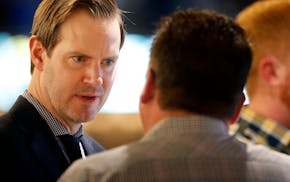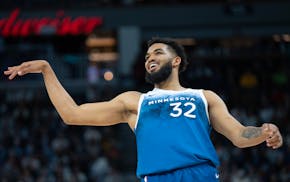The NAIA began using a four-team playoff to determine a national champion in 1958. St. John's had gone unbeaten in 1962 and was hopeful of an invitation to the playoff that never came. ¶ "We had heard some things late in the season that, if we stayed unbeaten, we were going to make it,'' John Gagliardi said. "We were following what was happening around the country closely. And nervously.''
Gagliardi was in his 11th season at Collegeville in 1963. He would last 60, before retiring after 2012 with more wins (489) than any coach in college football history.
St. John's had closed its second consecutive 8-0 regular season with a 32-7 victory over archrival St. Thomas on Nov. 2. It took until the middle of the month for St. John's to find out that it had been selected for the NAIA playoff and would play Emporia [Kan.] State in a semifinal.
Arrangements were made to play the game Nov. 30 at Met Stadium. The other semifinal was Prairie View A&M of Texas playing at Kearney State in Nebraska on Dec. 7.
The Johnnies blew out Emporia 54-0 on a bitterly cold day in Bloomington. A week later, Prairie View defeated Kearney 20-7.
The NAIA came up with this money-saving plan to get the two winners to Sacramento, Calif., to decide the national title in the Camellia Bowl: The Panthers from Prairie View would hang tight in Nebraska and the charter flight that carried St. John's out of Minneapolis would stop and pick them up.
Prairie View was a historically black college from near Houston. St. John's was a bastion of whiteness in the woods of central Minnesota.
"Remember, this was two weeks after President Kennedy was assassinated,'' said Ken Roering, a standout end for the Johnnies. "There was unrest over civil rights, and then the president was shot … it was such a crazy time.
"We were a bunch of white kids from Minnesota who hadn't seen much of the world. And now we would be going up against a team from a black school in the South. We had no idea what to expect, and I'm sure the Prairie View players felt the same way about us.''
The Johnnies staked out a portion of the plane, flew to Nebraska and then waited for the opponents to board.
"They came walking down the aisle and there were so many big guys I didn't think we were going to be able to take off,'' Gagliardi said.
Gagliardi was getting started on his status as the legend of St. John's. Coach Billy Nicks was already that at Prairie View. The Pittsburgh Courier, a famed black newspaper, had named Nicks' Panthers as the national black college champions in 1953, 1954 and 1958, and would do so again in 1963 and 1964.
"We didn't have too much interaction as coaches,'' Gagliardi said.
"We were both trying to prepare for a game against opponents we didn't know much about.''
It was probably a good thing the Johnnies did not know many specifics about the players they would be facing.
There were eight players from that Prairie View team drafted by the NFL and/or AFL: quarterback Jim Kearney, defensive backs Ken Houston and Leon Carr, receiver Otis Taylor, halfback Ezell Seals and linemen Ray Scott, Ray Johnson and Carl Robinson.
Houston became a Pro Football Hall of Famer as a safety. Taylor was a great wide receiver for the Kansas City Chiefs. Kearney was a longtime starter as a strong safety for the Chiefs, including in the 1970 Super Bowl.
Taylor had six catches for 81 yards in that game, including a relentless run on a 43-yard touchdown late in the third quarter that basically clinched the Chiefs' 23-7 upset of the Vikings.
Bernie Beckman, a 5-8, 165-pound two-way back at St. John's, said: "I saw Otis Taylor in that Super Bowl and thought, 'How did we ever stop him? How did we beat that team?' ''
Good question, but it happened — 33-27 for the Johnnies.
Prairie View blocked a punt and scored on its first offensive play, and scored again when Taylor pulled a pass from a crowd of defenders and went 61 yards.
That made it 14-6, but the Johnnies scored 20 points in a row, and then put the game away with Craig Muyres' 19-yard pass to Hardy Reyerson in the fourth quarter.
"You get out there and connect at the line a few times and say, 'Holy cow, is he strong,' '' Roering said. "But you dig down a little deeper and say, 'This doesn't hurt like I thought it was going to.'
"Then, you see you can move the ball against them. And you get a punt return from [Bob] Spinner for a touchdown, and an interception from [John] McCormick for another touchdown, and you're in the ballgame.
"That's how it happens. That's how you beat a great team like Prairie View.''
One more factor: "We were pretty good ourselves.''
Patrick Reusse can be heard 3-6 p.m. weekdays on AM-1500.

Reusse: Success on court helped Timberwolves do strong business

Reusse: Taylor's story. 'I just bought the Minnesota Timberwolves.'

Reusse: Back from injury, Towns doesn't have to carry load

